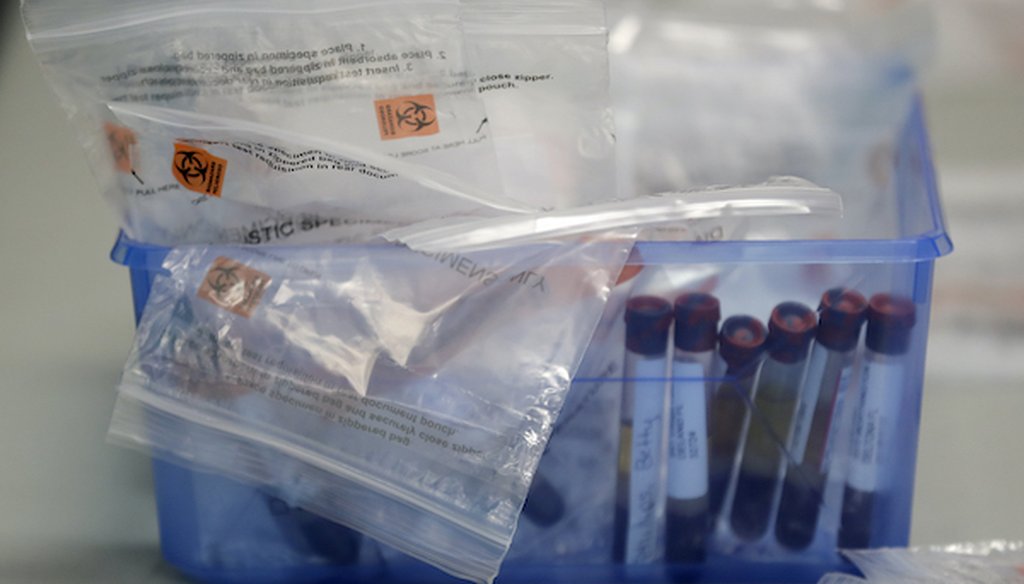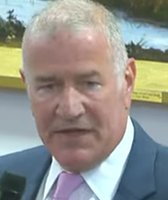Get PolitiFact in your inbox.

Before being sent to a lab, blood samples from COVID-19 antibody tests are packed in a container at the Volusia County Fairgrounds on May 5, 2020, in DeLand, Fla. (Associated Press)
If Your Time is short
-
The main types of coronavirus tests — diagnostic, antibody and antigen — are in different stages of development and have varying levels of accuracy.
-
Testing supply shortages vary across labs but have been made worse by an overwhelmed international supply chain.
-
Contact tracing, which involves tracking patients and who they’ve interacted with, is a common public health strategy that experts say is key to slow the spread of the coronavirus and reopening the economy.
Coronavirus testing, and everything that goes along with it, has permeated the news cycle.
That’s because the testing situation — in the United States and abroad — is complicated, and continues to change.
Health officials say that adequate and rapid testing, as well as contact tracing, are paramount to slow the spread of COVID-19 and navigate a return to public life.
It can be hard to keep up with which test does what. So we compiled what we know about the process so far to get you separating antibody from antigen.
Where the U.S. is on testing right now
Testing for the novel coronavirus continues to tick up in the United States, but public health experts say it’s still a drop in the bucket compared with the amount needed for a country of 330 million people.
Sign up for PolitiFact texts
So far, around 7 million Americans have been tested for the virus. Approximately 235,000 people are currently being tested in the country per day.
That sounds like a lot. But to safely restart the U.S. economy, the country needs to be doing at least 5 million tests per day by early June, according to a study by Harvard University. The study said that number should reach 20 million tests per day by late July.
Whether the Trump administration believes the U.S. can hit that figure depends on the speaker. President Donald Trump suggested the U.S. may be able to carry out 5 million tests per day "very soon." But Adm. Brett Giroir, assistant secretary for health in charge of the government’s testing response, told Time there’s "absolutely no way on Earth, on this planet or any other planet, that we can do 20 million tests a day, or even 5 million tests a day."
The Harvard assessment is "an unreasonable benchmark," Giroir said.
The White House blueprint for ramping up testing capacity largely leaves states in charge of developing plans and rapid-response programs. The plan says the federal government should act as the "supplier of last resort" for tests.
The different types of coronavirus tests
There are three main tests that health officials mention as they talk about what’s needed to restart the economy.
Tests for confirming the disease: Diagnostic (polymerase chain reaction, or PCR)
Diagnostic tests determine whether someone is currently infected with the novel coronavirus. They are considered the most common and reliable.
Diagnostic tests, which are also known as PCR tests, look for the genetic material of the coronavirus in a sample that’s typically taken from a person’s nose or throat. It uses polymerase chain reaction technology to amplify any viral genetic material that may be present.
These tests are known to be the most accurate, but it usually takes several days to get results.
To speed up the process, Abbott Laboratories made its "ID NOW" rapid PCR test, which can produce results in 13 minutes. But when it was reported that the tests were producing a high number of false negatives, the company advised health care providers not to store patient samples in solutions known as "viral transport media." Abbott said the swabs should be placed directly into the device and then the test will work as expected.
Tests to determine who was already infected: Antibody
Antibody tests, also known as serology tests, identify whether a person was previously infected with the virus. It does not detect the virus itself.
The tests are designed to detect the presence of antibodies — proteins that are key elements of the body’s immune response to germs. Antibodies would be present in people who battled the coronavirus and recovered, as well as in people who had been exposed but whose infection was so mild that they didn’t notice they were sick.
These are usually blood tests and can be taken from a finger prick or a vein. Results typically only take a few minutes, but the biggest issue is accuracy.
The Food and Drug Administration issued a policy in March that allowed for antibody tests to be brought to market without the usual review process. This enabled more than 100 commercial tests to flood the market, many of which were of low quality. Facing widespread criticism over the approach, the FDA revised the policy on May 4 and announced new standards for testing developers.
READ MORE: Antibody tests: The promise and pitfalls of using them to reopen the US
Tests to identify people infected with the virus, with less lab work: Antigen
Antigen tests are designed to detect a specific antigen, which is considered to be any foreign substance that the immune system fights against.
Researchers say antigen testing could be part of a broader solution to quickly screen patients for infection.
But there are no coronavirus antigen tests currently approved by the FDA.
Antigen tests, like PCR (diagnostic) tests, would be used to determine infection and require nasal swabs. But antigen tests would look for viral proteins on the virus’ surface, while PCR tests look for genetic material carried inside the virus.
Antigen tests are typically quick and easy and use the same technology as a rapid strep test. The tests can be done in a doctor’s office and can produce results in minutes.
PCR tests tend to be more sensitive, and thus, more accurate than antigen tests.
A few reasons why the US lags in testing
Supply shortages
Supply shortages have plagued coronavirus testing in the U.S, and some labs are faring better than others.
Swabs and reagents, in particular, have been in high demand. These materials are used to collect and process samples for coronavirus testing, and the sudden worldwide demand for them has strained the supply chain and slowed down testing. (Swabs are used to collect samples from people’s noses or throats; reagents are chemicals used to identify the virus in the tests.)
Government agencies continue to approve and incorporate testing supply alternatives in an attempt to fix the problem. The Centers for Disease Control and Prevention, for example, now says various types of swabs can be used in certain situations, and the FDA greenlit the use of a broader range of swabs and relaxed other guidelines on storing samples.
READ MORE: Swabs and reagents: The coronavirus test materials everyone is talking about
The fractured supply chain
The U.S. outsources some of the materials it needs for testing, and a global run on the same supplies has bottlenecked a complex international supply chain.
The shortages are constantly changing.
"At one point it was test kits, at another it was swabs," said Louise Serio, a spokesperson for the American Clinical Laboratory Association that includes Quest and LabCorp. "But one constriction in the chain of supply can suddenly create a bottleneck. That's why it's important that labs have reliable access to all of the supplies and equipment necessary to perform the tests."
Some of the supplies needed for testing, like a lot of the test kits, come from Europe, but other supplies might be sourced from India, Italy, China, or the United States.
Lab officials also say that some of the major testing manufacturers are based overseas and typically make the majority of their products near, or around, their headquarters.
READ MORE: The international supply chain behind coronavirus testing
Lack of preparedness and a botched rollout
The United States’ testing woes seem to have kicked off with a late and failed rollout of testing kits from the CDC. The kits turned out to be faulty and forced the agency to recall the tests.
Another blow, some experts say, was a lack of foresight going back years.
The U.S. has strategic emergency reserves of items like oil and milk, but didn’t treat testing components the same way, said Davey Smith, chief of infectious diseases and global public health at the University of California-San Diego. There was no emergency supply of swabs or reagents.
Contact tracing
Contact tracing is a common public health strategy and has been used to slow other diseases. It involves tracking the movements of patients and who they’ve interacted with — possibly by using their cell phones.
Health workers conduct contact tracing by learning as much as they can about who a patient has been in contact with, so they can be notified about their potential exposure and urged to isolate.
State and local public health officials are hiring thousands of new contact tracers, but some experts say the federal government needs to spend billions of dollars to bolster those efforts.
Our Sources
Time, Trump Says U.S. Will Run 5 Million Daily Virus Tests 'Very Soon.' His Testing Chief Says That's Impossible, April 28, 2020
Harvard University, Roadmap to pandemic resilience, April 20, 2020
CovidTracking.com, US Historical Data, Accessed May 4, 2020
CNN, What to know about the three main types of coronavirus tests, April 29, 2020
NBC News, What is antigen testing? How a new test could help track the coronavirus outbreak, April 28, 2020
NPR, How Reliable Are COVID-19 Tests? Depends Which One You Mean, May 1, 2020
PolitiFact, COVID-19 testing: Where we are now, April 17, 2020
PolitiFact, Swabs and reagents: The coronavirus test materials everyone is talking about, April 21, 2020
PolitiFact, The international supply chain behind coronavirus testing, April 28, 2020
PolitiFact, Antibody tests: The promise and pitfalls of using them to reopen the US, April 15, 2020
PolitiFact, Contact tracing: How it's used to fight COVID-19, April 17, 2020




































